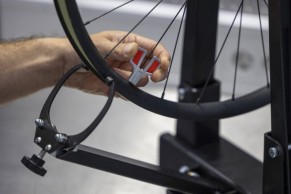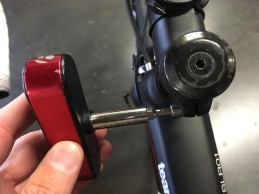Shimmy Effect: why some bikes become uncontrollable when going downhill
There are few things scarier on a bike than when we're speeding downhill and suddenly, without warning, the bike starts to vibrate and shake violently. This is known as the Shimmy Effect. We explain how it occurs and what to do if it appears on one of your descents.

Shimmy Effect, the most terrifying thing that can happen to you on a bike
Descending hills on a bike is one of the most exciting and fun aspects of this sport. However, for many cyclists it represents a tremendous situation of stress and anxiety due to the fear that descents generate. A fear of falling that can completely block the cyclist, if not, ask Enric Mas during the 2022 Tour de France.
Luckily, during descents, going down fast and safe mostly depends on aspects that we can control by knowing and applying certain techniques. And we say mostly because there are some things that are beyond our control and can put us in a real danger. Perhaps, the most feared of these uncontrollable factors is the Shimmy Effect.
RECOMENDADO

Fat Max Training to efficiently eliminate fat

Change wheels if you want to transform your bike's behavior

What bike size do you need? Here's how to find out

How does age affect performance and recovery?

How long cyclists can be pushed when handed a sticky bottle?

10 tips for safer and faster downhills on road bikes
Many of you will wonder, what the hell is the Shimmy Effect? You've probably suffered it on some occasion without knowing it had that name. It is an uncontrollable and violent vibration that starts in the steering and spreads to the whole bike making it very difficult to stay on it. The worst thing is that it usually appears at high speeds so the risk of getting hurt if we don't know how to react quickly and instinctively is very high.

The Shimmy Effect is related to what in physics is known as resonance, an effect that occurs when the frequency of the waves that affect a system coincide with the natural frequency of that system. When this happens, a kind of coupling occurs that significantly increases the amplitude of these waves, i.e., they are amplified. In fact, this phenomenon is used in the amplifiers of sound systems.
However, in most cases, the effects of resonance are not desirable. Surely many of you have seen videos on the net of bridges wobbling and oscillating until they collapse when the frequency induced by the wind coincides with that of the bridge itself.
As for the bike, the Shimmy Effect occurs when the mix of all the frequencies that affect the bike: the vibrations that come up from the ground, those induced by the wind, by the cyclist's position, by the wheels that are impossible to be perfectly centered or by the flexion of the material align to coincide with the natural frequency of the system amplifying that vibration in the front train which results in strong shakes in the steering.

Luckily, modern carbon bikes, increasingly more rigid but, at the same time with laminates studied to dissipate the vibrations that come from the road, or having wider tires that filter much more the irregularities have made the Shimmy Effect almost forgotten. However, despite all this, there is always the possibility that everything aligns for the Shimmy Effect to end up appearing. Besides, the geometries of current bikes, longer, with less vertical steering and more trail that tends to self-align the front wheel have greatly reduced the possibility of the Shimmy Effect appearing.
This is so because there are several factors that favor the appearance of the Shimmy Effect such as off-center wheels, bearings of the same with play or also that we have play in the steering, which will be, after all, a source of vibrations, so it is advisable to be prepared and know what we can do if the Shimmy Effect appears.
As a curiosity, the Shimmy Effect is also a headache for motorcyclists, so much so that sports motorcycles usually mount what is known as steering dampers. A hydraulic damper that connects the handlebar and the frame and whose function is precisely to pacify the uncontrolled vibrations produced by the Shimmy Effect that, at the speeds that these types of motorcycles can run, appears very frequently.
How to fix the Shimmy Effect on your bike
First of all, as you may have guessed, having our bike in perfect working order, with all its parts perfectly adjusted, will be essential to prevent the appearance of the Shimmy Effect. And that's because, when it appears, it usually does so violently that we have a lot of chances to end up with our bones on the ground.
Checking the centering of the wheels, especially the front one, and the correct adjustment of the steering, without it having play and, at the same time, that it is not hard. Of course, the condition of the bearings, both of the steering and of the wheels can also be a trigger of the Shimmy Effect. A bearing with a small hard point will generate a vibration that will have as frequency the one marked by the speed at which it rotates.

But, what if despite all the precautions the Shimmy Effect ends up appearing? Above all, keep calm and weather the storm. If we panic, the situation will probably end badly.
The Shimmy Effect can not only occur on descents. On many occasions it occurs, at lower speeds, when we let go of our hands. In that case, it is easy to solve, just put your hands back on the handlebar for the vibrations to cease. This is so because by doing so, not only do we add rigidity to the steering assembly but at that moment our body integrates into the system varying the resonance frequency of the assembly that no longer coincides with that of the vibrations that have caused the Shimmy Effect.

Much more dangerous is when it occurs on a descent since, as we mentioned, it is normal for it to happen at high speed. Obviously, by reducing the speed the frequencies of the vibrations that produce the Shimmy Effect will change and the bike will stop shaking. However, if we let fear take over and, instinctively, we look for the brakes, it is most likely that the tires will exceed their grip capacity due to the shakes resulting in a fall.
Neither is holding the handlebar tightly a solution as the shakes caused by the Shimmy Effect can be very violent and it is likely that they will destabilize us. That's why it's important to try to relax your arms so that we absorb these shakes as if they were bumps, all this while we let the speed decrease.
However, the most effective thing we can do, just like in the case of hands on the handlebar, is to change the resonance frequency of the system so that it no longer resonates with the vibrations that affect the bike. Something we can achieve by squeezing our knees against the horizontal tube of the bike.

Besides, to favor the loss of speed without touching the brake, we will take advantage of aerodynamics, raising the body as much as possible so that it is the air itself that makes us brake and the Shimmy Effect ceases as soon as possible.
We hope that with these tips you can know how to react if this dangerous situation occurs on your bike.